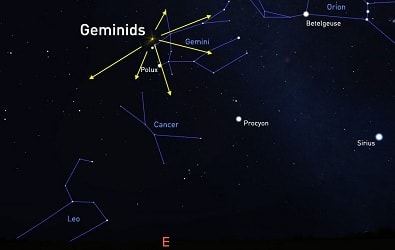
Star-lovers and sky-enthusiasts can enjoy a meteor shower display on December 13 after 10 p.m., and in the early morning hours of December 14, named the Geminid meteor shower.
Rocks and dust particles from space that are about to collide with Earth's atmosphere are called meteoroids. Those that enter and streak through the atmosphere are called meteors.
Usually when comets, which are chunks of ice with lot of dust, come close to the sun, the ice melts and the dust and rocks are left behind along the orbit of the comet.
If Earth, in its yearly motion around the Sun happens to pass through such a debris trail, they enter the Earth's atmosphere with considerable speed and due to friction in the atmosphere, burns up and give rise to not only a single bright streak in the sky but numerous meteors, called meteor shower.
Why is the Geminid meteor shower called so?- Geminid meteor shower is so named because the meteors appear to originate from the constellation of Gemini in the night sky.
- It is not a comet but an unusual asteroid called 3200 Phaethon, discovered in 1983, that is the origin of the meteors.
- Asteroids are rocky bodies going round the Sun, originating from a region between the orbit of Mars and Jupiter.
- Unlike the planets, their orbits are sometimes extremely elliptical and intersect the orbit of Mars and even Earth.
- The Earth-orbit-crossing asteroids are called Apollo Asteroids.
3200 Phaethon- 3200 Phaethon, named after the son of the Sun god Helios, is an Apollo Asteroid that may have undergone a collision with another object in the distant past to produce the stream of particles that Earth runs into - creating this meteor shower.
- 3200 Phaethon, a 5.1-k.m.-long piece of rock, has characteristics which are close to a comet. In its close approach to Sun, it sheds huge amount of rock and dust in its path and Earth happens to pass that path every year during December 4-16.
- Generally, the meteor shower associated with 3200 Phaethon peaks around second week of December every year and are quite numerous.